

Blogging: Teaching Students How to Quality Comment - Cooper on Curriculum. After co-presenting on blogging at EdcampNYC and then blogging about the significance of student work being made public, I have heard lots of conversation and questions regarding how to teach students to comment on each other’s blog posts.
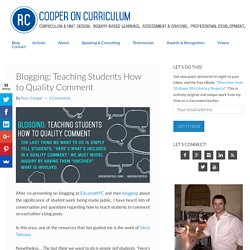
In this area, one of the resources that has guided me is the work of Silvia Tolisano. Nonetheless…The last thing we want to do is simply tell students, “Here’s what’s included in a quality comment.” We must model inquiry by having them “uncover” what is involved. Then, students will (1) have a deeper understanding of why these components are significant, and (2) be more likely to apply them. Here’s what this process could look like: In small groups, students explore authentic blog post comments, which should probably be vetted by the teacher ahead of time.
In reality, quality commenting falls under the same category as teachers and students providing feedback on each other’s work. Outlook Web App. Silvia Tolisano- Langwitches Blog. Difference between social and academic commenting.
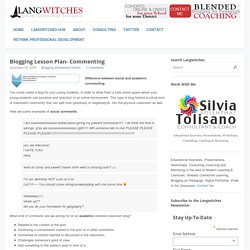
You could create a blog for your young students, in order to allow them a safe online space where your young students can socialize and “practice” in an online environment. This type of blog fosters a virtual kind of classroom community that can spill over (positively or negatively)Â into the physical classroom as well. Here are some examples of social comments. I am soooooooooooooo exited about giving my present tommorow!!!!! I do think the time is wronge. ytou are sooooooooooooooo right!!!!! You are ridiculous! What its funny and sweet!! I’m am definitely NOT a pro at it lol. Heeeeeeyy!!
What kind of comments are we aiming for on an academic oriented classroom blog? Commenting etiquette While we hope that the content of a comment is meaningful and related to the post and learning, there is yet another dimension to commenting. Learning How to Comment! Most of Mrs.
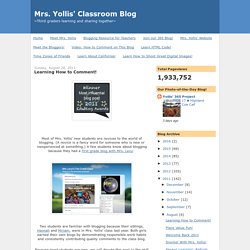
QuadBlogging Connects Student Writers with Global Audiences. A blog without an audience is like...a library without books, a car without an engine, Beyonce without a ring.
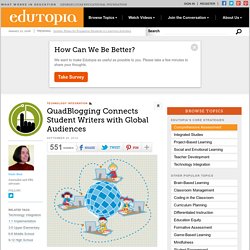
Those were some of the responses David Mitchell (@DeputyMitchell) got when he asked his Twitter followers to fill in the blank. "We all understand the importance of audience," says Mitchell, an educator from the United Kingdom and vocal proponent of using blogs to engage student writers. His latest strategy to connect students with readers around the world is the online phenomenon known as QuadBlogging. The idea is deceptively simple. Four teachers agree to have their students comment on each other's blogs in an organized fashion. Mitchell hatched the idea almost by chance with three other schools in the UK. Measurable Benefits Mitchell, deputy headmaster at Heathfield Community Primary School in Bolton, England, isn't exaggerating when he says blogging leads to better writing. Along with measurable results, Mitchell has gathered plenty of anecdotal evidence.
Global Replication. Three Tips for Classroom Blogging Projects. Just getting back to school with your students?
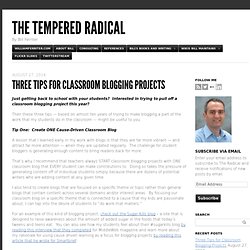
Interested in trying to pull off a classroom blogging project this year? Then these three tips — based on almost ten years of trying to make blogging a part of the work that my students do in the classroom — might be useful to you: Tip One: Create ONE Cause-Driven Classroom Blog A lesson that I learned early in my work with blogs is that they are far more vibrant — and attract far more attention — when they are updated regularly. The challenge for student bloggers is generating enough content to bring readers back for more.
Ten Ways to Use Discussion Forums to Promote Digital Citizenship and Academics. More and more classrooms are opening their doors to student discussion online.
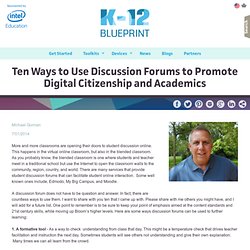
This happens in the virtual online classroom, but also in the blended classroom. As you probably know, the blended classroom is one where students and teacher meet in a traditional school but use the Internet to open the classroom walls to the community, region, country, and world. There are many services that provide student discussion forums that can facilitate student online interaction.
Some well known ones include, Edmodo, My Big Campus, and Moodle. A discussion forum does not have to be question and answer. 1. 2. 3. - 10 Tools To Engage Students In Academic Discussion Forums- Digital Citizenship Series. 0 Comments May 26, 2014 By: Michael Gorman.
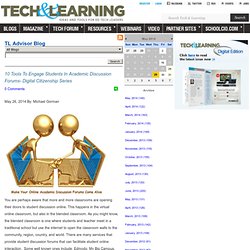
Education Week. Blogging is as much about sharing with one another as it is about getting your own voice out.

This week marks my second year anniversary blogging for Education Week. There probably won't be a cake decorated with frosting and candles to celebrate the anniversary, and my Education Week editors may not even know it's been two years (yes, I'm dropping a hint). I'm sure I won't get gifts sent to me or any medals of honor, but what I have gotten over the past two years is much more valuable. The most important part of blogging are the relationships I have created with people I had never met before. Blogging can be an awesome experience if it is done correctly. If you add in social networking such as Twitter into the mix, blogs have the capability of being read by people all over the world. Through this experience, I have met (virtually or in person) many educators. Madlon taught all over the world, including places like Beirut.
Blogger. WordPress.com - Get a Free Blog Here. Safe and simple blogs for your students.